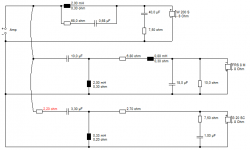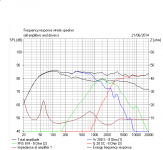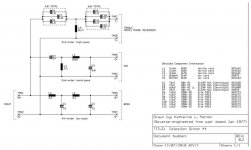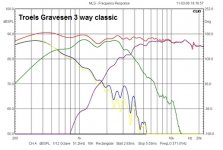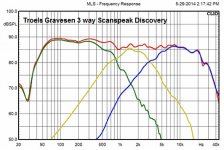This is interesting. Having been surprised by the success of the admirable 3-Way Classic, Troels Gravesen has published a new time-aligned design according to 5th element! Enter the ScanSpeak 3-way Discovery with ring radiator tweeter. 🙂
ScanSpeak-3W-Discovery
He's a vague on crossover details because it's a kit. But I've had a look at it.
You're possibly more familiar with LR2 and LR4 parallel 2 way designs time-aligned, and series filters do interesting things too:
I'll move on to the theory of 3 ways, and deconstruct the crossover in the next posts, if you'll bear with me. 🙂
ScanSpeak-3W-Discovery
He's a vague on crossover details because it's a kit. But I've had a look at it.
You're possibly more familiar with LR2 and LR4 parallel 2 way designs time-aligned, and series filters do interesting things too:
An externally hosted image should be here but it was not working when we last tested it.
I'll move on to the theory of 3 ways, and deconstruct the crossover in the next posts, if you'll bear with me. 🙂
Continuing this look at the ScanSpeak-3W-Discovery.
Steen Duelund laid the theory of time aligned 3 ways on a mathematical footing. The ideal 3 way is a mythical beast, because it needs an absolutely ideal midrange driver, which doesn't exist.
However, some other good designs work well enough.
You start with a 24dB/octave LR4 two way with a non existent midrange driver:
Next is a filter where a midrange starts to creep in, and we are around 18dB/octave here:
The midrange works harder in the next example:
After that, it just becomes unrealistic, because the midrange must have huge bandwidth for all the drivers to operate at 12dB/octave LR2 and for the mid to do near all the work at crossover. You can read Steen Duelund's original Duelund Filter if you are interested. But we've got enough here. 🙂
Steen Duelund laid the theory of time aligned 3 ways on a mathematical footing. The ideal 3 way is a mythical beast, because it needs an absolutely ideal midrange driver, which doesn't exist.
However, some other good designs work well enough.
You start with a 24dB/octave LR4 two way with a non existent midrange driver:
An externally hosted image should be here but it was not working when we last tested it.
Next is a filter where a midrange starts to creep in, and we are around 18dB/octave here:
An externally hosted image should be here but it was not working when we last tested it.
The midrange works harder in the next example:
An externally hosted image should be here but it was not working when we last tested it.
After that, it just becomes unrealistic, because the midrange must have huge bandwidth for all the drivers to operate at 12dB/octave LR2 and for the mid to do near all the work at crossover. You can read Steen Duelund's original Duelund Filter if you are interested. But we've got enough here. 🙂
OK, last part of this look at the ScanSpeak-3W-Discovery.
Troels doesn't time align the bass and mid, because the error in wavelength is small. What he goes for is roughly this:
I'd guess that tweeter is set back about 2cms, which is enough to line up phase nicely on second order filters with that particular tweeter. For interest, I knocked up something similar in Visaton Boxsim. The downward slope is Troels' favoured BBC tilt, which sounds nice in a lot of people's opinion.
The sim is quite rough and ready, and I'm sure you could do better. But I hope you find that as interesting as I do. 🙂
Troels doesn't time align the bass and mid, because the error in wavelength is small. What he goes for is roughly this:
An externally hosted image should be here but it was not working when we last tested it.
I'd guess that tweeter is set back about 2cms, which is enough to line up phase nicely on second order filters with that particular tweeter. For interest, I knocked up something similar in Visaton Boxsim. The downward slope is Troels' favoured BBC tilt, which sounds nice in a lot of people's opinion.
The sim is quite rough and ready, and I'm sure you could do better. But I hope you find that as interesting as I do. 🙂
Attachments
Last edited:
Did you build\listened to your design? Could you compare it to Troel's?
Can please explain the different approach?
Can please explain the different approach?
It might sound strange, but I really don't have to build a speaker to know how it sounds. But I have chosen drive units that will work.🙂
I can MODEL them so accurately that the only variable left is the actual sound quality of the individual drivers.
Currently I am listening to a pair of ancient Celestion Ditton 44, with a crossover below:
Very good three ways, with all the speed, accuracy and dispersion that two way owners can only dream of.
What I'm doing here, is looking at the theory of time aligned three ways.
AFAIK, no-one has been able to explain this simply. But my view is that it IS simple. Just try and get your speaker looking like the above response.
So if you want to build a three way, just get it as close to the above. Troels Gravesen is keeping his circuits simple, but you can look at his two major recent efforts and see if you might refine them armed with the correct theory. What is impressive about the maths of it, is that this theory will still be true in a thousand years time! 😎
Thankyou for your interest, ranhaber.
I can MODEL them so accurately that the only variable left is the actual sound quality of the individual drivers.
Currently I am listening to a pair of ancient Celestion Ditton 44, with a crossover below:
An externally hosted image should be here but it was not working when we last tested it.
Very good three ways, with all the speed, accuracy and dispersion that two way owners can only dream of.
What I'm doing here, is looking at the theory of time aligned three ways.
An externally hosted image should be here but it was not working when we last tested it.
AFAIK, no-one has been able to explain this simply. But my view is that it IS simple. Just try and get your speaker looking like the above response.
So if you want to build a three way, just get it as close to the above. Troels Gravesen is keeping his circuits simple, but you can look at his two major recent efforts and see if you might refine them armed with the correct theory. What is impressive about the maths of it, is that this theory will still be true in a thousand years time! 😎
Thankyou for your interest, ranhaber.
Attachments
Einstein didn't measure anything, but other people eventually did to prove his theories correct.
Although I don't agree with DavidL's particularly harsh approach to things he is right in that you do need to make measurements to confirm that what's happening really is happening otherwise, as with Einstein, it is just conjecture, based off of what is theoretically correct.
Personally I find pure simulation work to be a pain in the behind. All the work you have to go through to put together what could theoretically be an accurate representation for your drivers in your box. It's so much more effective and time saving, to simply pull out the mic and measure the loudspeaker. Once that's done the real fun can begin, as in designing the crossover properly.
Something like the frd consortium's guide to designing loudspeakers without measurements is all well and good, but it can only take you so far. It's perfect for those who don't have measuring equipment and just want to build the odd loudspeaker. But for those who are really serious about it, buy a mic and preamp and measure stuff, it's as simple as that.
Steve, I do find it a little odd that you've obviously got a good background, education and strong interest in loudspeaker design. You also invest a lot of time and energy towards this and yet you don't appear to have a mic and preamp (these don't have to be expensive). Now while the simulations are perfect for assisting people with their haphazard and clumsily put together designs, for your own, where you've got the loudspeakers on hand, nothing beats the microphone!
Although I don't agree with DavidL's particularly harsh approach to things he is right in that you do need to make measurements to confirm that what's happening really is happening otherwise, as with Einstein, it is just conjecture, based off of what is theoretically correct.
Personally I find pure simulation work to be a pain in the behind. All the work you have to go through to put together what could theoretically be an accurate representation for your drivers in your box. It's so much more effective and time saving, to simply pull out the mic and measure the loudspeaker. Once that's done the real fun can begin, as in designing the crossover properly.
Something like the frd consortium's guide to designing loudspeakers without measurements is all well and good, but it can only take you so far. It's perfect for those who don't have measuring equipment and just want to build the odd loudspeaker. But for those who are really serious about it, buy a mic and preamp and measure stuff, it's as simple as that.
Steve, I do find it a little odd that you've obviously got a good background, education and strong interest in loudspeaker design. You also invest a lot of time and energy towards this and yet you don't appear to have a mic and preamp (these don't have to be expensive). Now while the simulations are perfect for assisting people with their haphazard and clumsily put together designs, for your own, where you've got the loudspeakers on hand, nothing beats the microphone!
Please, can we just settle down a bit?
Steve started this thread to show an analysis of one of Troels' designs. Can we please just let hime do it, then the likes some earlier posters can post their generally pointless negativism?
PLEASE, JUST LET HIM FINISH?
Steve started this thread to show an analysis of one of Troels' designs. Can we please just let hime do it, then the likes some earlier posters can post their generally pointless negativism?
PLEASE, JUST LET HIM FINISH?
I thought S7 was doing an intellectual exercise just showing the theory behind the design?
Cheers, wayne
Cheers, wayne
Steve, could you please define what you axactly mean by "time aligned" ?
Regards
Charles
Here you go!
I don't think that the answer could found that way. Maybe you didn't notice that I asked about how HE defines time-aligned. ;-)
Regards
Charles
Regards
Charles
Firstly I should reiterate what we are doing here. We are looking at Troels' new design in the context of the work done by Steen Duelund.
And what we are saying, is that IF Steen was right, and I think he was, a time aligned 3 way speaker which looks like this will sound rather good. THAT is the prediction of the theorists for the builders to work at. 🙂
Some designers like Siegfried Linkwitz and John Kreskovsky use this mathematical theory a great deal.
If I seem rather theoretical, it is a matter of allocating my time where it is most effective. I am quite content to use Visaton's publihed FRD and ZMA files rather than measure my own. It's all bit like the theoretical physicists who said to the experimenters to look around 125GeV for the Higgs Boson. Once they've done the calculations, they have finished their bit, and move on to looking for the next new particles which arise. 😀
Interestingly, a time aligned two way has considerable problems. It doesn't seem to work as tidily as you would expect, or at least it throws up some surprises which make you reevaluate what is possible.
But that is for another day. 😎
And what we are saying, is that IF Steen was right, and I think he was, a time aligned 3 way speaker which looks like this will sound rather good. THAT is the prediction of the theorists for the builders to work at. 🙂
An externally hosted image should be here but it was not working when we last tested it.
Some designers like Siegfried Linkwitz and John Kreskovsky use this mathematical theory a great deal.
If I seem rather theoretical, it is a matter of allocating my time where it is most effective. I am quite content to use Visaton's publihed FRD and ZMA files rather than measure my own. It's all bit like the theoretical physicists who said to the experimenters to look around 125GeV for the Higgs Boson. Once they've done the calculations, they have finished their bit, and move on to looking for the next new particles which arise. 😀
Interestingly, a time aligned two way has considerable problems. It doesn't seem to work as tidily as you would expect, or at least it throws up some surprises which make you reevaluate what is possible.
An externally hosted image should be here but it was not working when we last tested it.
But that is for another day. 😎
I don't think that the answer could found that way. Maybe you didn't notice that I asked about how HE defines time-aligned. ;-)
Regards
Charles
To answer that question as best I can, time alignment is actually quite hard to define. In practise it is the placement of the acoustic centres so you get the phase alignment predicted by theory. For instance a two way with LR4 (24dB/octave) slopes should be working reasonably well on phase with the drivers in positive polarity at a certain alignment.
An externally hosted image should be here but it was not working when we last tested it.
A shallower LR2 (12dB/octave) slope filter should be working well on phase with negative polarity.
Usually it's just putting the tweeter back a couple of centimeters. The theory of acoustic centres is a bit peculiar in practise. A cone is not a point source for one thing, and as I hinted earlier, LR filters don't actually work very well on phase alignment in two ways. Surprisingly, Butterworth and Tchebycheff slopes are better.
Last edited:
 I've deleted some off topic thread crapping. DavidL you are skating on very thin ice!
I've deleted some off topic thread crapping. DavidL you are skating on very thin ice! I didn't delete one of the posts due to the fact 5th's post would have lost context.
This is a very interesting thread, and revives an interest I pursued (at least on a theoretical level) a few years ago.
I don't think Steve said so explicitly, but as I understand it the advantage of the filler driver is the perhaps surprising fact that it can transform a perfectly acceptable all-pass and constant power, but not linear-phase, two-way system into a three-way system which is linear phase across most of its bandwidth. Time alignment of the drivers is a necessary but not sufficient requirement for this.
I wrote a little page on this many moons ago which, I hope explains how it works with the aid of a little maths. As Steve points out, this technique puts enormous demands on the midrange driver, as it needs to have a bandwidth much wider than you might think.
Alex
I don't think Steve said so explicitly, but as I understand it the advantage of the filler driver is the perhaps surprising fact that it can transform a perfectly acceptable all-pass and constant power, but not linear-phase, two-way system into a three-way system which is linear phase across most of its bandwidth. Time alignment of the drivers is a necessary but not sufficient requirement for this.
I wrote a little page on this many moons ago which, I hope explains how it works with the aid of a little maths. As Steve points out, this technique puts enormous demands on the midrange driver, as it needs to have a bandwidth much wider than you might think.
Alex
Troels design reminds me somewhat of the physically time aligned Mission 770 Freedom speakers. Albeit, the latter were 2-ways.
Mathematics is fine art for those who understand! I don't. But what is relevatn to loudspeakers is the acoustic response of each driver and how they are summing in phase.
I think System7 has gone a little too far in his thinking, from Gravesen's 3W Discovery.
Also I think that it is not justified for a mid in a 3-way to call it a "filler" when it has range of 2 octaves and more, even if it is done in LR2 (acoustic) or Duelundish. The key is to make each driver's response curving symmetrically, to hold phase match and subsequently summing in coherence.
If we use LR4 type slopes, W and T are in much lover spl when they cross and leave more duty for the mid. With LR4 the phase rolls more than with LR2 of course, but does that really matter, if phase match is coherent? Speaaker Transient Analysis
Time alignment is important and difficult with passive crossovers. Even more critical with shallow slopes (LS2) of mid-tweeter xo because of the short wavelenth. Proper time alignment can only be measured to a single point in space - usually at listening axis 2m distance. Alignment has two components, electrical (crossover) and mechanical (distance to microphone), the sum of these. Poor phase match leads to comb filtering and increased 3rd harmonic noise.
Sophisticated loudspeaker design/simulation programs use actual measurements with distance data, and provide means to phase matching (LSPcad, SoundEasy) - if done well!
A nice article here http://www.dv2.fr/article/delay_alignment_a_survey.pdf
I think System7 has gone a little too far in his thinking, from Gravesen's 3W Discovery.
Also I think that it is not justified for a mid in a 3-way to call it a "filler" when it has range of 2 octaves and more, even if it is done in LR2 (acoustic) or Duelundish. The key is to make each driver's response curving symmetrically, to hold phase match and subsequently summing in coherence.
If we use LR4 type slopes, W and T are in much lover spl when they cross and leave more duty for the mid. With LR4 the phase rolls more than with LR2 of course, but does that really matter, if phase match is coherent? Speaaker Transient Analysis
Time alignment is important and difficult with passive crossovers. Even more critical with shallow slopes (LS2) of mid-tweeter xo because of the short wavelenth. Proper time alignment can only be measured to a single point in space - usually at listening axis 2m distance. Alignment has two components, electrical (crossover) and mechanical (distance to microphone), the sum of these. Poor phase match leads to comb filtering and increased 3rd harmonic noise.
Sophisticated loudspeaker design/simulation programs use actual measurements with distance data, and provide means to phase matching (LSPcad, SoundEasy) - if done well!
A nice article here http://www.dv2.fr/article/delay_alignment_a_survey.pdf
Last edited:
Juhazi, you raise a lot of issues there, but the mathematics is inescapable whether you like it or not. But do notice the slopes are actually not exactly LR4 or LR2, there are all sorts of slopes in Duelund filters as you play with the variables.
Indeed it's familiar stuff, speakerdoctor. We've had a couple of diy time aligned designs here. This is Michelino's KEF-based stepped baffle which I liked a lot
Joachim Gerhard (who I suppose qualifies as a DIY man here...😀) has a lovely sloped baffle in his SEAS based commercial Anima speaker. He said he used third order butterworth (18dB/octave):
I appreciate what Alex was saying about the filler driver concept in two ways. It is neat mathematically, but near impossible in practise. Lynn Olson thought it was broken when I asked him about it. You actually wire the bass and tweeter out of phase and fill the hole with the filler driver, which is different from the usual three way IIRC.
I find it interesting that you might combine the bass and mid slopes into an LR2 slope on a bassmid, and combine it with a LR4 tweeter. This would be an assymetric filter that might have very good phase alignment similar to a three way. In fact it is something we do quite a lot anyway. But now we know why it works.
Troels design reminds me somewhat of the physically time aligned Mission 770 Freedom speakers. Albeit, the latter were 2-ways.
Indeed it's familiar stuff, speakerdoctor. We've had a couple of diy time aligned designs here. This is Michelino's KEF-based stepped baffle which I liked a lot
An externally hosted image should be here but it was not working when we last tested it.
Joachim Gerhard (who I suppose qualifies as a DIY man here...😀) has a lovely sloped baffle in his SEAS based commercial Anima speaker. He said he used third order butterworth (18dB/octave):
An externally hosted image should be here but it was not working when we last tested it.
I appreciate what Alex was saying about the filler driver concept in two ways. It is neat mathematically, but near impossible in practise. Lynn Olson thought it was broken when I asked him about it. You actually wire the bass and tweeter out of phase and fill the hole with the filler driver, which is different from the usual three way IIRC.
An externally hosted image should be here but it was not working when we last tested it.
I find it interesting that you might combine the bass and mid slopes into an LR2 slope on a bassmid, and combine it with a LR4 tweeter. This would be an assymetric filter that might have very good phase alignment similar to a three way. In fact it is something we do quite a lot anyway. But now we know why it works.
Last edited:
- Status
- Not open for further replies.
- Home
- Loudspeakers
- Multi-Way
- Troels Gravesen Time Aligned 3 way published.
